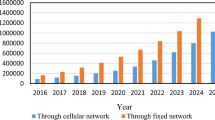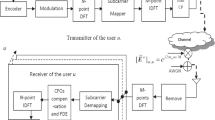Abstract
The nonlinear distortion of the power amplifier (PA) is studied for Filtered Orthogonal Frequency Division Multiplexing (F-OFDM) systems, which will be adopted in the fifth generation (5G) mobile communication systems. The peak to average power ratio (PAPR) of F-OFDM signal may make the PAs work in the saturation region and result into extremely serious nonlinear saturation distortion, and the nonlinear saturation distortion is usually compensated by predistortion technology. A digital predistortion (DPD) structure is designed to compensate the nonlinear characteristics of the PA in the article. Firstly, repeated iterative clipping revision (RICR) algorithm is used to reduce the PAPR, which makes the working region of PA infinitely close to the saturation region, and as a result, the efficiency is improved. Furthermore, an integrated structure combining crest factor reduction (CFR) and DPD is employed. The experimental results show that the performance of the proposed CFR joint adaptive DPD lowers the PAPR of the predistorted signal by 2dB. The combined CFR & DPD reduces the ACPR of the transmitter by 3dB compared with the unlinearized PA.








Similar content being viewed by others
References
Andrews, J. G., Buzzi, S., Wan, C., et al. (2014). What will 5G be? IEEE Journal on Selected Areas in Communications, 32(10), 1065–1082.
Wunder, G., Jung, P., Kasparick, M., et al. (2014). 5GNOW: non-orthogonal, asynchronous waveforms for future mobile applications. IEEE Communications Magazine, 52(2), 97–105.
Banelli, P., Buzzi, S., Colavolpe, G., et al. (2014). Modulation formats and waveforms for 5G networks: who will be the heir of OFDM? An overview of alternative modulation schemes for improved spectral efficiency. IEEE Signal Processing Magazine, 31(6), 80–93.
Matthe, M., Zhang, D., Schaich, F., Wild, T., Ahmed, R., & Fettweis, G. (2016). A Reduced Complexity Time-Domain Transmitter for UF-OFDM. In IEEE Vehicular Technology Conference (VTC Spring).
Pooria, Varahram, & Borhanuddin, M. A. (2013). Low complexity partial transmit sequence with complex gain memory predistortion in OFDM systems, Wireless Personal Communications, 68(4), 1435–1448.
Nader, C., Landin, P. N., Van Moer, W., et al. (2012). Peak-power controlling technique for enhancing digital pre-distortion of RF power amplifiers. IEEE Transactions on Microwave Theory and Techniques, 60(11), 3571–3581.
Zhao, J., Liu, Y., & Yu, C. (2015). A novel two-dimensional crest factor reduction for performance improvement of RF power amplifiers. IEEE Microwave and Wireless Components Letters, 25(12), 835–837.
Sandoval, F., Poitau, G., & Gagnon, F. (2017). Hybrid peak-to-average power ratio reduction techniques: Review and performance comparison. IEEE Access, 5, 27145–27161.
Anoh, K., Tanriover, C., & Adebisi, B. (2017). On the optimization of iterative clipping and filtering for papr reduction in OFDM ssystems. IEEE Access, 5, 12004–12013.
Wang, S., Morgan, R., & Caroline, L. P. (2018). Impact of crest factor reduction and digital pre-distortion on linearity and power efficiency power amplifier. IEEE Transactions on Circuits and Systems II: Express Briefs,. https://doi.org/10.1109/TCSII.2018.2855084.
Mbaye, A., Baudoin, G., Gouba, A., Louet, Y., & Villegas, M. (2014) Combining crest factor reduction and digital pre-distortion with automatic determination of the necessary crest factor reduction gain. 2014 44th European Microwave Conference, pp. 837–840.
Saleh, A. (1983). Adaptive linearization of power amplification in digital radio system. Bell System Technical Journal, 64(4), 1019–1033.
Shanying, Wu, Hau, S. F. S., & Wong, Y. M. (2005). The use of nonlinear curve fitting in digital predistortion for linearizing RF power amplifiers (pp. 960–963). Beijing: Springer.
Wang, S., Hussein, M. A., Venard, O., & Baudoin, G. (2018). A novel algorithm for determining the structure of digital pre-distortion models. IEEE Transactions on Vehicular Technology, 67(8), 7326–7340.
Author information
Authors and Affiliations
Corresponding author
Additional information
Publisher's Note
Springer Nature remains neutral with regard to jurisdictional claims in published maps and institutional affiliations.
Rights and permissions
About this article
Cite this article
Qing, M., Luo, Z. A Combined Approach of DPD and CFR in F-OFDM System. Wireless Pers Commun 114, 2681–2691 (2020). https://doi.org/10.1007/s11277-020-07497-7
Published:
Issue Date:
DOI: https://doi.org/10.1007/s11277-020-07497-7




